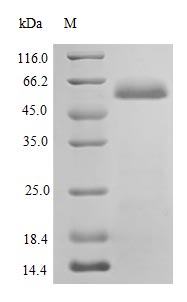Recombinant Human Protein disulfide-isomerase protein (P4HB) is expressed in E. coli and features an N-terminal 6xHis-tag. The protein is produced as a partial sequence from amino acids 19 to 508, with a purity exceeding 95% as determined by SDS-PAGE. It exhibits biological activity, specifically thiol protein reductase activity, measured at 0.001 Δ650nm/min-2. The endotoxin level is maintained below 1.0 EU/μg, as tested by the LAL method.
Protein disulfide-isomerase (P4HB) appears to play a crucial role in catalyzing the formation and rearrangement of disulfide bonds in proteins—a process that seems essential for proper protein folding and stability. The enzyme operates within various cellular pathways, particularly those related to oxidative protein folding in the endoplasmic reticulum. P4HB may be a key player in ensuring proper protein conformation and function, which likely makes it significant across diverse research areas.
Potential Applications
Note: The applications listed below are based on what we know about this protein's biological functions, published research, and experience from experts in the field. However, we haven't fully tested all of these applications ourselves yet. We'd recommend running some preliminary tests first to make sure they work for your specific research goals.
1. Protein Folding and Disulfide Bond Formation Studies
This recombinant P4HB protein is highly suitable for studying protein disulfide isomerase activity. The confirmed thiol protein reductase activity in the insulin reduction assay provides direct evidence that the protein is functionally active. The high purity (>95%) and low endotoxin level support its use in sensitive biochemical assays. Researchers can confidently use this protein to investigate the kinetics of disulfide bond rearrangement and its role in oxidative protein folding pathways. Comparative studies with other PDI family members are feasible and well-supported by the validated activity.
2. Enzyme Kinetics and Inhibitor Screening Assays
This application is well-supported and directly validated by the provided activity data. The established insulin reduction assay (turbidity at 650 nm) provides a robust platform for detailed enzyme kinetics studies (Km, Vmax) and for screening potential PDI inhibitors. The low endotoxin level is particularly valuable for cell-based follow-up studies. The recombinant P4HB protein is an excellent reagent for quantitative analysis of enzyme performance and for screening compound libraries for PDI modulators.
3. Antibody Development and Immunoassay Applications
The high purity, low endotoxin, and confirmed bioactivity make this recombinant P4HB an excellent immunogen for generating specific antibodies. The N-terminal 6xHis tag facilitates purification and immobilization for antibody screening. Importantly, since the protein is bioactive and likely correctly folded, antibodies generated have a higher probability of recognizing native, functional P4HB in biological samples. The recombinant P4HB protein is suitable as a positive control in Western blotting, ELISA, and other immunoassays.
4. Pull-down Assays and Protein-Protein Interaction Studies
The His-tagged, bioactive recombinant P4HB is suitable for pull-down experiments to identify protein substrates or binding partners. The confirmed biological activity strongly suggests proper folding, increasing the likelihood of identifying physiologically relevant interactions. The high purity minimizes background binding. This protein can be used to map PDI's interactome and study its role in various biological pathways with greater confidence than an unvalidated protein.
Final Recommendation & Action Plan
This recombinant P4HB protein is a high-quality, functionally validated reagent suitable for all proposed applications. The confirmed thiol reductase activity confirms it is properly folded and bioactive, overcoming the primary limitation of unvalidated recombinant proteins. Researchers can proceed directly with functional studies, including enzyme kinetics, inhibitor screening, and protein interaction mapping, without the need for initial activity validation. For interaction studies, the protein can be used in pull-down assays with confidence in its native conformation. For antibody development, the protein's confirmed activity increases the likelihood of generating antibodies that recognize functional P4HB. The low endotoxin level further expands its utility to cell-based assays. This protein represents a well-characterized tool for P4HB research.






